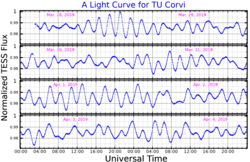Astronomy:TU Corvi
| Observation data Equinox J2000.0]] (ICRS) | |
|---|---|
| Constellation | Corvus |
| Right ascension | 12h 35m 58.79603s[2] |
| Declination | −20° 31′ 38.9160″[2] |
| Apparent magnitude (V) | 6.20[3] |
| Characteristics | |
| Spectral type | F0 V[4] |
| B−V color index | 0.34±0.01[3] |
| Variable type | δ Sct[5][6] |
| Astrometry | |
| Radial velocity (Rv) | −2.0±4.3[7] km/s |
| Proper motion (μ) | RA: +30.202[2] mas/yr Dec.: −51.280[2] mas/yr |
| Parallax (π) | 13.2558 ± 0.3343[2] mas |
| Distance | 246 ± 6 ly (75 ± 2 pc) |
| Absolute magnitude (MV) | 2.08[3] |
| Details | |
| Mass | 1.45[8] M☉ |
| Radius | 2.7[2] R☉ |
| Luminosity | 12.6+1.2 −1.1[8] L☉ |
| Surface gravity (log g) | 3.93±0.14[8] cgs |
| Temperature | 7,132±242[8] K |
| Metallicity [Fe/H] | −0.07±0.07[9] dex |
| Rotational velocity (v sin i) | 103[10] km/s |
| Age | 786[8] Myr |
| Other designations | |
| Database references | |
| SIMBAD | data |
TU Corvi is a yellow-white hued star in the southern constellation of Corvus. It is a dimly visible to the naked eye with an apparent visual magnitude of 6.20.[3] The distance to this star can be estimated from its annual parallax shift of 13.3 mas, yielding a range of about 246 light years. Based upon measured changes in its proper motion, it may be a close binary system.[12]
This is an F-type main-sequence star with a stellar classification of F0 V.[4] Previously it had been classed as F0 III,[13] matching an evolved giant star. It is a Delta Scuti variable, varying by an amplitude of 0.025 in B magnitude with a period of 118 minutes.[5][6] At the age of 786[8] million years, it has a high rate of spin with a projected rotational velocity of 103 km/s.[10] The star has 1.45 times the mass of the Sun and is radiating 12.6 times the Sun's luminosity from its photosphere at an effective temperature of 7,132 K.[8]
References
- ↑ "MAST: Barbara A. Mikulski Archive for Space Telescopes". Space Telescope Science Institute. https://mast.stsci.edu/portal/Mashup/Clients/Mast/Portal.html.
- ↑ 2.0 2.1 2.2 2.3 2.4 2.5 Vallenari, A. et al. (2022). "Gaia Data Release 3. Summary of the content and survey properties". Astronomy & Astrophysics. doi:10.1051/0004-6361/202243940 Gaia DR3 record for this source at VizieR.
- ↑ 3.0 3.1 3.2 3.3 Anderson, E.; Francis, Ch. (2012). "XHIP: An extended hipparcos compilation". Astronomy Letters 38 (5): 331. doi:10.1134/S1063773712050015. Bibcode: 2012AstL...38..331A.
- ↑ 4.0 4.1 Houk, Nancy; Smith-Moore, M. (1978). Michigan catalogue of two-dimensional spectral types for the HD stars. 4. Ann Arbor: Dept. of Astronomy, University of Michigan. Bibcode: 1988mcts.book.....H.
- ↑ 5.0 5.1 Samus', N. N; Kazarovets, E. V; Durlevich, O. V; Kireeva, N. N; Pastukhova, E. N (2017). "General catalogue of variable stars: Version GCVS 5.1". Astronomy Reports 61 (1): 80. doi:10.1134/S1063772917010085. Bibcode: 2017ARep...61...80S.
- ↑ 6.0 6.1 Watson, Christopher (4 January 2010). "TU Corvi". The International Variable Star Index. American Association of Variable Star Observers. http://www.aavso.org/vsx/index.php?view=detail.top&oid=10698. Retrieved 21 July 2015.
- ↑ de Bruijne, J. H. J.; Eilers, A.-C. (October 2012). "Radial velocities for the HIPPARCOS-Gaia Hundred-Thousand-Proper-Motion project". Astronomy & Astrophysics 546: 14. doi:10.1051/0004-6361/201219219. A61. Bibcode: 2012A&A...546A..61D.
- ↑ 8.0 8.1 8.2 8.3 8.4 8.5 8.6 David, Trevor J.; Hillenbrand, Lynne A. (2015). "The Ages of Early-type Stars: Strömgren Photometric Methods Calibrated, Validated, Tested, and Applied to Hosts and Prospective Hosts of Directly Imaged Exoplanets". The Astrophysical Journal 804 (2): 146. doi:10.1088/0004-637X/804/2/146. Bibcode: 2015ApJ...804..146D.
- ↑ Gáspár, András et al. (August 2016), "The Correlation between Metallicity and Debris Disk Mass", The Astrophysical Journal 826 (2): 14, doi:10.3847/0004-637X/826/2/171, 171, Bibcode: 2016ApJ...826..171G
- ↑ 10.0 10.1 Zorec, J.; Royer, F. (2012). "Rotational velocities of A-type stars. IV. Evolution of rotational velocities". Astronomy & Astrophysics 537: A120. doi:10.1051/0004-6361/201117691. Bibcode: 2012A&A...537A.120Z.
- ↑ "TU Crv". SIMBAD. Centre de données astronomiques de Strasbourg. http://simbad.u-strasbg.fr/simbad/sim-basic?Ident=TU+Crv.
- ↑ Mason, Brian D. et al. (1999). "Speckle Interferometry of New and Problem HIPPARCOS Binaries". The Astronomical Journal 117 (4): 1890. doi:10.1086/300823. Bibcode: 1999AJ....117.1890M.
- ↑ Cowley, A. et al. (April 1969). "A study of the bright A stars. I. A catalogue of spectral classifications". Astronomical Journal 74: 375–406. doi:10.1086/110819. Bibcode: 1969AJ.....74..375C.
 |


